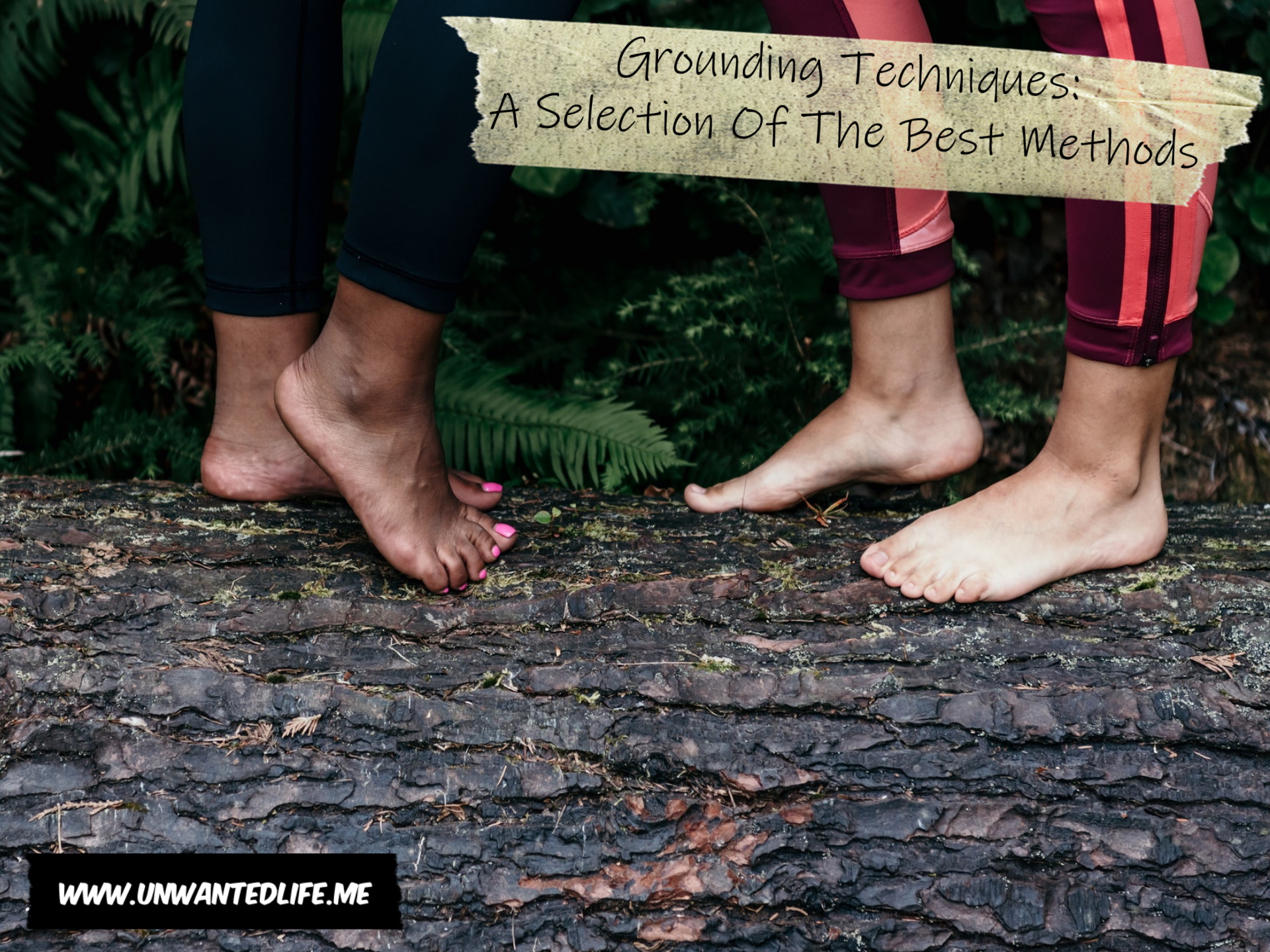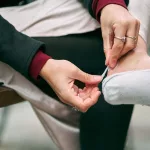Grounding methods are practices designed to help you reconnect with the present moment and divert attention away from overwhelming anxiety.
You can apply grounding techniques to create distance from upsetting emotions in almost any situation. They’re particularly useful for improving:
- anxiety
- overall well-being
- stress
- depression
- mood
- post-traumatic stress disorder (PTSD)
- dissociation

Physical grounding techniques
These approaches engage your five senses or use physical objects — things you can touch — to help you move through distress.
1. Place your hands in water
Notice the temperature of the water and how it feels on your fingertips, palms, and the backs of your hands. Is the sensation consistent across those areas?
Try warm water first, then cold. Then reverse it: cold first, then warm. Do you notice a different feeling when you switch from cold to warm versus warm to cold?
2. Pick up or touch nearby objects
Are the items you touch soft or firm? Heavy or light? Warm or cool? Focus on the texture and color of each object. Challenge yourself to identify specific shades—like crimson, burgundy, indigo, or turquoise—instead of merely red or blue.
3. Breathe deeply
Inhale slowly, then exhale. If it helps, silently or aloud say “in” and “out” with each breath. Notice the feeling of your lungs expanding and what it’s like to release the breath.
4. Savor a food or drink
Take small bites or sips of a food or drink you like, allowing yourself to fully taste each mouthful. Consider the flavor and aroma and the sensations that linger on your tongue.
5. Take a brief walk
Pay attention to your steps — you can even count them. Note the rhythm of your footsteps and the sensations as your foot meets the ground and lifts again.
6. Hold a piece of ice
What is the initial sensation? How long before it starts to melt? How does the feeling change as the ice melts?
7. Savor a scent
Is there a smell that comforts you? It could be a cup of tea, an herb, a favorite soap, or a scented candle. Inhale the scent slowly and deeply and try to describe its qualities (sweet, spicy, citrusy, etc.).
8. Move your body
Do a few movements or stretches. You might try:
- jumping jacks
- jumping up and down
- skipping rope
- jogging in place
- stretching various muscle groups individually
Notice how your body responds with each movement and when your hands or feet touch the floor or move through the air.
How does the ground feel beneath your feet and hands? If you’re skipping rope, listen for the sound of the rope cutting the air and hitting the floor.
9. Listen to your environment
Pause for a moment to hear the sounds around you. Are there birds? Dogs barking? Machines or traffic? If you hear people talking, what are they saying? Do you recognize the language?
Let the sounds ground you and remind you where you are.
10. Notice your body
You can do this seated or standing. Scan your body from head to toe, noticing each part. Consider:
- your hair resting on your shoulders or forehead
- the weight of your clothing on your shoulders
- whether your arms feel relaxed or tense at your sides
- your heartbeat — fast or steady
- whether your stomach feels full or you’re hungry
- whether your legs are crossed or your feet are on the floor
Curl your fingers and wiggle your toes. Are you barefoot or wearing shoes? How does the surface feel beneath your feet?
11. Practice the 5-4-3-2-1 exercise
Counting backward from 5, use your senses to name things you notice around you. For example:
- 5 things you hear
- 4 things you see
- 3 things you can touch from where you sit
- 2 things you can smell
- 1 thing you can taste
Make an effort to notice small details you might normally overlook, like the color flecks in a carpet or the hum of a device.
Mental grounding techniques
These exercises rely on cognitive distractions to redirect your thoughts away from distress and back to the present moment.
12. Play a memory game
Study a detailed photograph or image (for instance, a busy city scene) for 5–10 seconds. Then turn it face-down and reconstruct the image in your mind with as much detail as possible. Or mentally list everything you remember from the picture.
13. Think in categories
Pick one or two broad categories, like “musical instruments,” “ice cream flavors,” or “baseball teams.” Spend a minute mentally listing as many items in each category as you can.
14. Work with numbers
Even if math isn’t your strong suit, numbers can help center you.
Try:
- running through a multiplication table in your head
- counting backward from 100
- choosing a number and thinking of five ways to make that number (6 + 11 = 17, 20 – 3 = 17, 8 × 2 + 1 = 17, etc.)
15. Recite something
Bring to mind a poem, song lyric, or passage you know by heart. Quietly recite it to yourself or say it in your head.
If you speak the words aloud, attend to how each word shapes your lips and mouth. If you say them internally, visualize the words as they’d appear on a page.
16. Make yourself laugh
Invent a silly joke — the kind you might find on a candy wrapper or a popsicle stick.
You could also watch a favorite funny animal clip, a comedian’s bit, or any short video that reliably makes you laugh.
17. Use an anchoring statement
Try a statement like, “I’m Full Name. I’m X years old. I live in City, State. Today is Friday, June 3. It’s 10:04 a.m. I’m sitting at my desk at work. No one else is in the room.”
Add details until you feel steadier, for example: “It’s lightly raining, but I can still see sunlight. It’s my break time. I’m thirsty, so I’ll make a cup of tea.”
18. Visualize a routine task you like or tolerate
If you enjoy doing laundry, imagine how you’d put away a finished load.
“The clothes are warm out of the dryer. They’re soft and slightly stiff. They feel light in the basket, although they spill over. I spread them across the bed to prevent wrinkles. I fold towels first, shaking them out, then folding in halves and thirds,” and so forth.
19. Describe a familiar task
Think through an activity you perform frequently or do well—making coffee, locking your office, or tuning a guitar. Walk through the steps as if instructing someone else.
20. Imagine leaving the painful feelings behind
Picture:
- gathering the emotions, crumpling them up, and placing them in a box
- walking, swimming, biking, or running away from the painful feelings
- your thoughts as a song or show you dislike—changing the channel or lowering the volume. They’re still there, but you don’t have to attend to them
21. Describe your surroundings
Spend a few minutes observing your environment and noting what you see. Use all five senses to capture as much detail as you can.
“This bench is red, while that one is green. It’s warm under my jeans because I’m in the sun. The surface feels rough but has no splinters. The air smells faintly of smoke. I hear children laughing and dogs barking.”
Soothing grounding techniques
These strategies are meant to comfort you during emotional distress. They encourage pleasant sensations that can help reduce the intensity of negative feelings.
22. Picture the face or voice of someone you love
If you’re upset, bring to mind a positive person in your life. Visualize their face or recall the sound of their voice. Imagine them reassuring you that this moment is hard but that you’ll get through it.
23. Practice self-compassion
Repeat kind, supportive phrases to yourself:
- “You’re having a hard time, but you’ll get through this.”
- “You’re resilient, and you can move through this pain.”
- “You’re doing your best, and that matters.”
Say the phrases aloud or in your head as often as you need.
24. Sit with your pet
If you’re at home and have an animal companion, spend a few moments sitting with them. If they’re furry, stroke them and focus on the texture of their fur. Note their markings or special traits. If you have a small pet you can hold, concentrate on how they feel in your hands.
Not at home? Think of the things you love about your pet or how they would comfort you if present.
25. List favorites
Name three favorites in various categories, such as:
- foods
- trees
- songs
- movies
- books
- places
26. Visualize your favorite place
Recall your favorite spot, whether it’s a loved one’s home or a destination abroad. Using all your senses, imagine the sounds, sights, and smells.
Try to remember the last time you were there. Think about what you did and how it felt.
27. Plan an activity
Think about something you might do alone or with someone else. Imagine the details: what you’ll do and when. Maybe you’ll go out for dinner, stroll along the beach, see a movie you’ve been wanting to watch, or visit a museum.
Focus on specifics like what you’ll wear, when you’ll go, and how you’ll get there.
28. Touch something comforting
Reach for a comforting object: a favorite blanket, a well-worn T-shirt, a smooth stone, or anything that feels pleasant to the touch. Notice how it feels under your fingers or in your palm.
If you have a beloved sweater, scarf, or socks, put them on and spend a moment noticing the fabric against your skin.
29. List positive things
Write down or mentally name four or five things in your life that bring you joy, briefly visualizing each one.
30. Listen to music
Put on a favorite song but imagine you’re hearing it for the first time. Focus on the melody and lyrics (if present).
Does the music give you chills or another physical sensation? Notice the parts that stand out most.
How grounding techniques work
Although there’s limited research clarifying exactly how grounding techniques operate, they’re a widely used approach for managing PTSD and anxiety.
Grounding draws on visualization and sensory input—sight, sound, smell—to distract from distressing thoughts or feelings. Like mindfulness, these methods help you return your attention to the present moment.
During a panic attack or flashback, emotions can overwhelm both thought and bodily responses. Anchoring yourself in the present through grounding can interrupt these reactions and bring your mind and body back to a safer, calmer state.
Additional tips
Grounding yourself isn’t always straightforward. It can take time to discover which techniques suit you best in different circumstances.
Try these tips to get more from grounding practices:
- Practice: Practice grounding even when you’re not dissociating or distressed. Familiarity with an exercise can make it easier to use when you need it.
- Avoid assigning judgments: If you’re describing your surroundings, focus on objective details rather than evaluating them emotionally.
- Check in with yourself: Before and after a grounding exercise, rate your distress from 1 to 10. What level were you at initially? How much did it drop after the practice? This helps determine which techniques work best for you.
Grounding techniques can be effective tools for managing distressing thoughts in the moment. If you struggle to use them, a therapist might help you practice and refine the approaches.
It’s also important to work with a therapist to address the underlying causes of your distress. If you don’t yet have a therapist, see our guide to affordable therapy for options.
If you need assistance locating a mental health professional, try our FindCare tool here.
Frequently asked questions
What is the 5-4-3-2-1 grounding method or the rule of 5 grounding technique?
This method asks you to count backward from 5 using your senses. Start by naming 5 sounds you can hear, then proceed through your senses until you reach 1.
What does grounding do to your body?
Practicing grounding techniques can help manage experiences such as:
- distress
- traumatic flashbacks
- nightmares
- intense emotions like anger
- anxiety
It’s helpful to attempt a grounding exercise early when you notice discomfort starting. Don’t wait until distress escalates. If one technique doesn’t seem to help immediately, try sticking with it briefly before switching to another.
What are some grounding techniques for PTSD?
A range of grounding methods can support people with PTSD. These include focusing on the five senses, practicing breathing exercises, or using a grounding mat.
Learn more about different grounding approaches.
How long should you ground each day?
There’s no definitive research specifying a daily grounding duration. It can be useful to continue a technique until you feel returned to the present and the distress eases.
If you feel distressed frequently and are relying on grounding often, consider discussing these experiences with a mental health professional.
Does sitting on the grass count as grounding?
Sitting on grass can be grounding if you engage your senses while doing it. Try deep breathing or noticing the texture of the grass around you.
Can you do too much grounding?
There isn’t a set point at which grounding becomes excessive.
If you feel you’re spending a lot of time calming yourself with grounding techniques or they seem ineffective, it might be time to seek additional support. A therapist or other mental health professional can help you process distressing thoughts and suggest other coping methods.
How long do you have to ground to get the benefits?
Some grounding benefits may appear immediately. You might notice anxious or intrusive thoughts ease, and feel calmer and more centered. Regular practice can make it easier to return to the present more quickly when distress arises.
Over time, grounding can increase your mindfulness throughout the day and help reduce negative thought patterns.


















Leave a Reply
You must be logged in to post a comment.